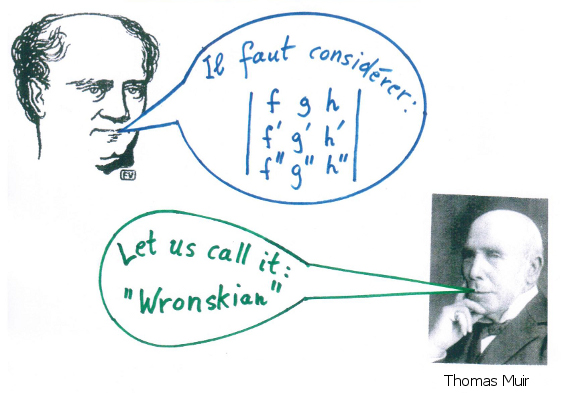The ubiquity of Wrońskians
Time: 11-18 October, 2011
Venue: Banach Center, Warsaw

REPORT
Organizers: Piotr Pragacz (chair) and Grzegorz Kapustka.
Invited speakers for the mathematical session:
Teresa Crespo (Barcelona),
Letterio Gatto (Torino),
Zbigniew Hajto (Cracow),
Maxim Kazarian (Moscow),
Inna Scherbak (Tel Aviv).
Invited speakers for the historical session:
Jacek Bartyzel (Toruń),
Mariusz Bochenek (Toruń),
Grzegorz Karwasz (Toruń).
*******
SUMMARY of the MATHEMATICAL SESSION:
We studied different incarnations of Wrońskians:
- those of linear systems in algebraic geometry;
- those in ordinary differential equations;
- those in singularity theory.
Letterio Gatto
gave 4 talks on:
"From Wrońskians of linear systems to Wroński-Schubert
Calculus".
Cf. the preprint: L.
Gatto, I. Scherbak: On Generalized Wronskians
See also Gatto's recent
paper: "The Wronskian and its derivatives" in:
http://www.actapeloritana.it/
Maxim E. Kazarian
gave 2 talks on:
"Wrońskian preserving deformations."
Abstract: We consider tuples of functions in one variable
depending on additional parameters. We study the partition
of the parameter space according to the degeneracy of their
Wronskians. The strata are labelled by collections of
Schubert symbols (Young diagrams). We formulate conditions
assuring triviality of the partition along the strata (which
does not always hold!). The talk is based on Kazarian's PhD
thesis (1993) and its accompanying
papers. It would be interesting to relate these result to
the modern study of Wronskians appearing in the context of
integrable systems, Bethe Ansatz of the Gaudin model, etc.
Cf. the article: M.E. Kazarian, Singularities of the
boundary of fundamental systems, flat points of projective
curves, and Schubert cells, J. Soviet Math. 52 (1990), 3338
- 3349.
Inna Scherbak and Maxim
Kazarian gave jointly 3 talks on:
"Schubert calculus in a Grassmannian, Wroński map and
generalized Wrońskians."
Abstract: There is a natural isomorphism between the
representation ring for gl and the cohomology ring of the
Grassmannian: both are governed by the Littlewood-Richardson
coefficients and the Schur functions.The correspondence is
classically known but it is
usually treated formally without any geometric explanation.
Nowadays there is a direct geometric construction provided
by the Gaudin model: it produces explicitly a basis in
the singular subspace of a given weight in the tensor
product of irreducible gl-modules starting from the
intersection points of the corresponding Schubert cycles on
the Grassmannian. Properties of the Wronskians play the key
role in this construction.
The correspondence works perfectly provided some
transversality condition is satisfied.
This condition usually holds but unfortunately there are
still cases when the
non-transversality is inevitable.
Cf. the article: E. Mukhin, V. Tarasov, A. Varchenko, Schubert calculus and representations of general linear group, arXiv:0711.4079
Teresa Crespo and
Zbigniew Hajto gave jointly 4 talks on:
"Picard-Vessiot extensions for real differential fields."
Cf. T.
Crespo, Z. Hajto, E. Sowa, Picard-Vessiot theory for real
fields
*******
In the HISTORICAL SESSION, we had 3 talks:
Jacek Bartyzel:
"Wprowadzenie do filozofii achrematycznej i metapolityki
mesjanicznej Hoene-Wrońskiego."
Grzegorz Karwasz:
"Lectures in Physics by Hoene-Wroński."
Mirosław Bochenek:
"Ekonomiczne dzieło Józefa Marii Hoene-Wrońskiego."
*******
Letterio Gatto prepared: LIST OF OPEN PROBLEMS
(Last modified on 4.12.2011.)
